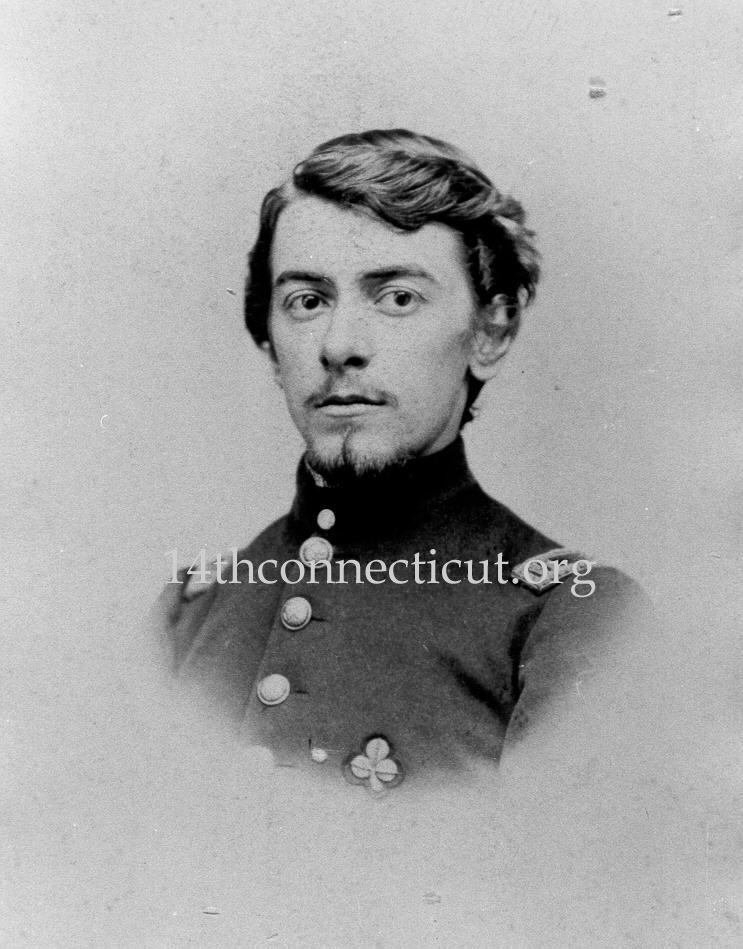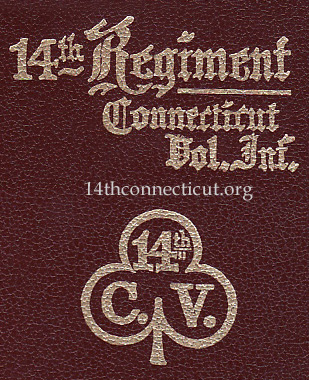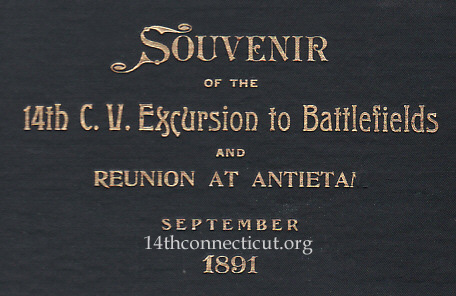![]()
History of
The Fourteenth Regiment C.V. Infantry
List of Engagements
Of The 14th
C.V.
Key:
♣ - Battles
* - Minor Engagements
& Skirmishes
♣
September 17, 1862
♣
December 12, 13, 14, 1862
♣
May 2 to 3, 1863
♣
July 2, 3, 4, 1863
* Falling Waters, MD
July 14, 1863
*
October 14, 1863
♣
October 14, 1863
*
October, 15, 1863
* Mine Run, VA
November 30, 1863
♣ Morton’s Ford, VA
February 6, 1864
♣ The Wilderness
(Todd’s Tavern), VA
May 5, 1864
♣ The Wilderness, VA
May 6, 1864
♣ Laurel Hill, VA
May 10, 1864
♣
May 12, 1864
*
May 13, 14, & 18, 1864
*
May 22, 1864
♣
May 24, 1864
*
May 26, 1864
♣
May 30, 1864
♣
June 3 & 5, 1864
*
June 16, 1864
♣
June 17, 1864
* Deep Bottom, VA
August 15, 16, 1864
♣ Ream’s Station
August 25, 1864
* Hatcher’s Run
(
October 27, 1864
*Hatcher’s Run, VA
February 5, 1865
* Hatcher’s Run, VA
March 29, 1865
*
Surrender of Lee’s Army
March 30 to April 10, 1865
14th C.V.I. Monuments
Antietam
Sharpsburg, MD
The Angle
Gettysburg, PA
Right Flank Marker
Gettysburg, PA
Bliss Barn Site
Gettysburg, PA
Bliss House Site
Gettysburg, PA
Written By Rev. Henry Stevens.
Late Chaplain of The Fourteenth Connecticut Volunteers
![]()
“The
organization of the Fourteenth Regiment began under the order promulgated May
22, 1862, to furnish
Recruiting for
the regiment began at once, but progressed slowly until, in July, after the
Union reverses on the Peninsula, the President called for three hundred thousand
volunteers for three years or the war, when it received a tremendous impulse and
the regiment filled up rapidly, being the first one to complete its organization
under that call. It was recruited from the State at large, having its
rendezvous, named “
August 23,
1862, the regiment was mustered into the
September 22d
the regiment marched to Bolivar Heights, near Harper’s Ferry, Va., remaining
there for picket and special duty until October 30th, when it went
down the Loudon Valley, Va., reaching Falmouth, near Fredericksburg, November 17th,
and on the next day was sent, with the brigade, to Belle Plain, on the Potomac,
for guard and fatigue duty. December 6th it rejoined the division at
April 28th
the regiment moved with the army on the
July 1st
Gettysburg was reached, and on the 2d the regiment was placed upon the ridge
where, at the center of the Second Corps, its brave men, the body now reduced in
size to a battalion, with their sturdy pluck and Sharps’ rifles materially
assisted in repulsing Longstreet’s grand charge on the afternoon of the 3d,
capturing five battle flags and more that two hundred prisoners. During the
forenoon of that day eight companies of the regiment captured the large brick
barn and the dwelling-house of William Bliss from the enemy’s sharpshooters, and
held the buildings until ordered to burn them, losing several men. This deed was
a brilliant and perilous one, as the buildings were nearly one-half mile in
front of our line, and the men were exposed, almost from the start, to a heavy
fire from sharpshooters in the buildings and from skirmishers and reserves.
July 6th
the regiment started with the army in pursuit of Lee; was engaged slightly at
Falling Waters, near Williamsport, Md., on the 14th; and then, by way
of Harper’s Ferry and Loudon Valley, proceeded to the vicinity of Catlett’s
Station, Va., and along Elk Run, Cedar Run, and near Bristersburg remained doing
picket duty until September 12th, except while on an expedition to
Hartwood Church, August 31st to September 3d, to support a force
designed to operate against rebel gunboats on the Rappahannock.
August 6th
the regiment received its first installment of recruits, conscripts, and
substitutes – the first-fruits of the draft in
September 13th
the regiment crossed the Rappahannock and moved to
The army
moving northward to intercept the enemy in an attempt to reach
Returning
southward, from October 23d to November 7th camp was near Warrenton,
and from November 10th to 26th near
February 6th,
1864, the regiment was engaged in the battle of Morton‘s Ford. The movement
involved wading the icy waters of the Rapidan, charges under fire of artillery
and infantry, and a hand-to-hand fight in the dark. The expedition was organized
as a diversion to aid a cavalry movement to rear of the enemy, but was
mismanaged. The Fourteenth fought splendidly, losing just one-half the number of
men lost by the whole division.
When the army
was reorganized in March the regiment became a part of the Third Brigade, Second
Division, Second Army Corps.
May 4th
the Rapidan was crossed, and the great forward movement of the army began; and
from May 5th to June 10th, the Fourteenth was passing over the “dark
and bloody ground” of the Wilderness campaign, engaged at Wilderness, Laurel
Hill, Spotsylvania, North Anna River, Tolopotomy, and Cold Harbor, losing daily
valuable officers and men, experiencing the hardships, labors, perils, and
sufferings incident to that unparalleled series of bloody struggles, and proving
themselves veterans of the first class.
June 14th
the James River was crossed, and Petersburg reached on the 15th, from
which date to early August the regiment was occupied in connection with various
siege operations in front of that place, taking part in a movement to Prince
George Court House June 27th to 29th, and an expedition to
Deep Bottom July 26th to July 30th, changing camp
continually.
August 12th
to 21st it participated in the second expedition to Deep Bottom,
involving a hard and trying march and in mid-summer‘s heat and some severe
skirmishing.
With but a few
hours rest after returning to
In early
November the regiment was on duty near Fort McGilvery, moving on the 29th
farther to the left to relieve a part of the Ninth Corps, and on the 6th
of December still farther on to relieve a portion of the 5th Corps.
From December
13th for a few weeks the Fourteenth had a period of comparative rest,
encamped near Fort Clark, February 5, 1864, the men were ordered out their
comfortable quarters to participate in another action at Hatcher‘s Run,
remaining on the field until the 10th, when they went into camp some
miles to the left of their recent camp. On the 25th of March the regiment, with
three other regiments of the brigade, all under command Lieutenant-Colonel Moore
of the Fourteenth, made a demonstration at the left of the Second Corps line,
capturing the enemy‘s works on the farther side of Hatcher’s Run, and about
seventy prisoners. This movement was intended as a diversion at the time of the
rebel attack upon
There followed
a rest of only two days and then the brave old “Fighting Fourteenth,” that had
known little else than campaigning and fighting, entered on it’s final campaign,
the movement of the Army of the Potomac that was to extinguish the Rebellion.
On the 28th
of March the corps left entrenchments, and from that day on, until the surrender
of Lee at Appomattox, the regiment was engaged in forced marching, skirmishing,
charging earthworks and lines of battle, and pressing the flying enemy, rounding
up its field history with a glory the greatest that could be coveted by the
patriotic Union soldier- “in at the death.”
The march was
hard and pressing, the discipline strict, and the rations very scanty, but hope
that the end of the war was near kept up the spirits of the men. They were at
the actions at
From April 14th
to May 2d was spent at
May 10th
witnessed their muster-out of the State service, with a record as to battles
fought, losses met, and hardships endured, unsurpassed by many regiments of the
Union army, and with the proud consciousness that they had served their country
in the hour of her peril and had helped to save the Union.
The service of
the Fourteenth was exceptional among the
The regiment
never lost a color, but captured several colors from the enemy; lost
comparatively few men as prisoners, though capturing many from the foe.
For months the
first State flag, rent by shell and bullet, was too much tattered to be
unfurled, and the new flag with which the State replaced it (August 25, 1863)
was nearly as badly wrecked before the regiment returned home.
It would
appear invidious among the many brave men of this sterling old regiment, who
fell or who proved their loyalty and valor in battle, to make distinctive
individual mention: but we may say that the organization was fortunate to a rare
degree in its leaders. Colonel Morris, commanding the brigade, and
Lieutenant-Colonel Perkins, a fine and thorough soldier, the regiment, at
Antietam, led their commands most gallantly, as did the latter and Major Clark
the regiment at Fredericksburg, where both were disabled for further field
service; while Major, subsequently Lieutenant-Colonel and Colonel, Ellis, one of
the most courageous, cool, and accomplished officers in the service, led it with
unsurpassed valor at Gettysburg and Bristoe Station, and the regiment, and at
times the brigade, through the Wilderness campaign. During much of the latter
campaign (as well as at Mine Run in November preceding) and afterwards, on to
the end of the war, in nearly every engagement Lieutenant-Colonel Moore, of
fiery, dashing courage, led the regiment. He was ably assisted, and sometimes
relieved in command, by Majors Coit, Broatch, and Hincks, and Adjutant Doten;
all men of character, ability, and staunchest courage - all receiving high
encomiums, never a censure. But most of the line officers and men at their backs
had kindred bravery and deserve like praise.”
From:
“Record
of Service of
 Henry Perkins Goddard |
 Regimental History |
 Souvenir
of the Excursion Souvenir
of the Excursion |
Antietam & Gettysburg Monument Dedications
| Record Of Events August
1862 - May 1865 |
Complete Roster Of The
14th CVI Field & Staff - Non-Commissioned Staff Company A Company B Company C Company D Company E Company F Company G Company H Company I Company K Unassigned Recruits & Casualties |